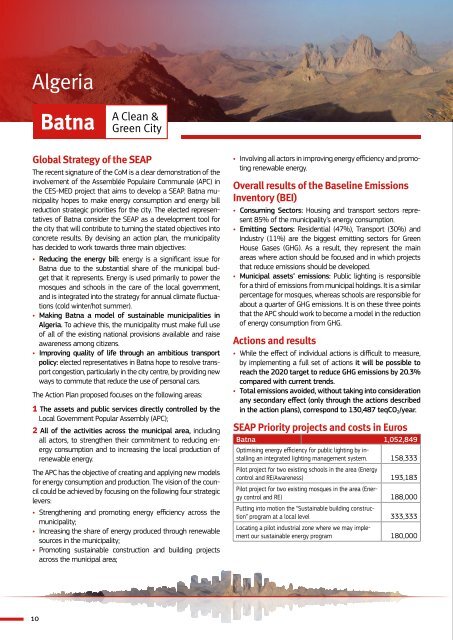CES-MED Milestones EN_WEB_rev July 2017
You also want an ePaper? Increase the reach of your titles
YUMPU automatically turns print PDFs into web optimized ePapers that Google loves.
Algeria<br />
Batna<br />
A Clean &<br />
Green City<br />
Global Strategy of the SEAP<br />
The recent signature of the CoM is a clear demonstration of the<br />
involvement of the Assemblée Populaire Communale (APC) in<br />
the <strong>CES</strong>-<strong>MED</strong> project that aims to develop a SEAP. Batna municipality<br />
hopes to make energy consumption and energy bill<br />
reduction strategic priorities for the city. The elected representatives<br />
of Batna consider the SEAP as a development tool for<br />
the city that will contribute to turning the stated objectives into<br />
concrete results. By devising an action plan, the municipality<br />
has decided to work towards three main objectives:<br />
• Reducing the energy bill: energy is a significant issue for<br />
Batna due to the substantial share of the municipal budget<br />
that it represents. Energy is used primarily to power the<br />
mosques and schools in the care of the local government,<br />
and is integrated into the strategy for annual climate fluctuations<br />
(cold winter/hot summer).<br />
• Making Batna a model of sustainable municipalities in<br />
Algeria. To achieve this, the municipality must make full use<br />
of all of the existing national provisions available and raise<br />
awareness among citizens.<br />
• Improving quality of life through an ambitious transport<br />
policy: elected representatives in Batna hope to resolve transport<br />
congestion, particularly in the city centre, by providing new<br />
ways to commute that reduce the use of personal cars.<br />
The Action Plan proposed focuses on the following areas:<br />
1 The assets and public services directly controlled by the<br />
Local Government Popular Assembly (APC);<br />
2 All of the activities across the municipal area, including<br />
all actors, to strengthen their commitment to reducing energy<br />
consumption and to increasing the local production of<br />
renewable energy.<br />
The APC has the objective of creating and applying new models<br />
for energy consumption and production. The vision of the council<br />
could be achieved by focusing on the following four strategic<br />
levers:<br />
• Strengthening and promoting energy efficiency across the<br />
municipality;<br />
• Increasing the share of energy produced through renewable<br />
sources in the municipality;<br />
• Promoting sustainable construction and building projects<br />
across the municipal area;<br />
• Involving all actors in improving energy efficiency and promoting<br />
renewable energy.<br />
Overall results of the Baseline Emissions<br />
Inventory (BEI)<br />
• Consuming Sectors: Housing and transport sectors represent<br />
85% of the municipality’s energy consumption.<br />
• Emitting Sectors: Residential (47%), Transport (30%) and<br />
Industry (11%) are the biggest emitting sectors for Green<br />
House Gases (GHG). As a result, they represent the main<br />
areas where action should be focused and in which projects<br />
that reduce emissions should be developed.<br />
• Municipal assets’ emissions: Public lighting is responsible<br />
for a third of emissions from municipal holdings. It is a similar<br />
percentage for mosques, whereas schools are responsible for<br />
about a quarter of GHG emissions. It is on these three points<br />
that the APC should work to become a model in the reduction<br />
of energy consumption from GHG.<br />
Actions and results<br />
• While the effect of individual actions is difficult to measure,<br />
by implementing a full set of actions it will be possible to<br />
reach the 2020 target to reduce GHG emissions by 20.3%<br />
compared with current trends.<br />
• Total emissions avoided, without taking into consideration<br />
any secondary effect (only through the actions described<br />
in the action plans), correspond to 130,487 teqCO 2 /year.<br />
SEAP Priority projects and costs in Euros<br />
Batna 1,052,849<br />
Optimising energy efficiency for public lighting by installing<br />
an integrated lighting management system. 158,333<br />
Pilot project for two existing schools in the area (Energy<br />
control and RE/Awareness) 193,183<br />
Pilot project for two existing mosques in the area (Energy<br />
control and RE) 188,000<br />
Putting into motion the “Sustainable building construction”<br />
program at a local level 333,333<br />
Locating a pilot industrial zone where we may implement<br />
our sustainable energy program 180,000<br />
10

















